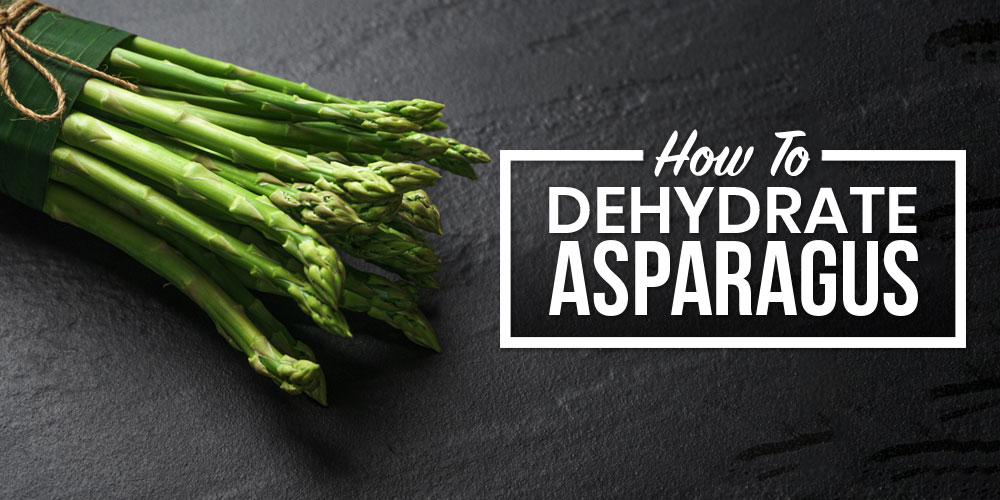
NAVIGATION
A perennial vegetable like asparagus will come back year after year, so keeping some clever preservation hacks in your back pocket is the best way to enjoy this once-a-year vegetable in any season.
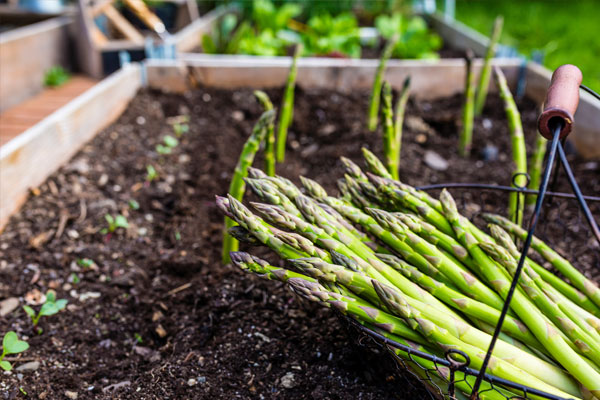

Hi, I’m Ryan
Each spring, my garden delivers more asparagus than I could possibly consume in a season. After a few years of enjoying and preserving this bountiful spring veggie, I’ve perfected the art of dehydrating asparagus so I can enjoy this vibrant flavor all year long.

Can You Dehydrate Asparagus?

Yes, asparagus is an excellent vegetable for dehydrating because it has a low water content, which makes for a quick and easy dehydration process. Dehydrated Asparagus also has an abundance of vitamins like A, C, and K, iron, potassium, and antioxidants. I love it for both its flavor and nutritional value.
What Varieties Of Asparagus Can Be Dehydrated?
The green variety is popular in America due to its robust and earthy flavor. White asparagus has a slightly sweeter taste but can be more fibrous. Purple asparagus is the sweetest and therefore has the highest sugar content.
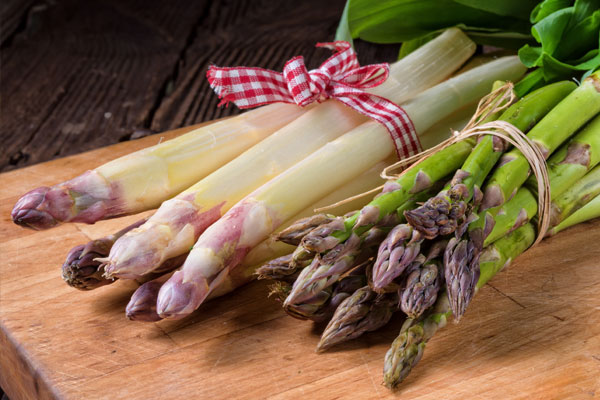
What Parts Of The Asparagus Can Be Dehydrated?
The entire asparagus stalk can be dried, but I usually remove the fibrous end of the stem first. You can dehydrate asparagus whole or cut into smaller pieces, depending on your preference or how you plan to use it later.
I like having the option of dehydrating the stems later to create a powder that can be used as a thickener for winter soups and stews. It may sound weird, but I find it important to use all parts of my vegetables without any waste.
Use a blender or mortar and pestle to grind dehydrated asparagus until it becomes a fine powder.
Do I Need To Peel Asparagus To Dehydrate Them?
For thicker varieties of asparagus, like the kind that grows in my garden, peeling the stalks before dehydrating is usually a good idea. The stem/stalk is larger at the bottom than at the top, so peeling the thicker areas allows for even dehydration.
A vegetable peeler is a quick, easy way to achieve your desired thickness. Lay the asparagus on a flat surface and use a vegetable peeler to shave it more evenly.
Do I Need To Blanch Asparagus To Dehydrate Them?
Yes, I recommend that you blanch asparagus before dehydrating. Blanching improves the texture, speeds up drying, and kills bacteria, so I find it’s worth the added effort. For asparagus, blanching also helps to minimize shrinking during dehydration.
To blanch, boil the asparagus for three minutes, and immediately transfer to an ice bath to stop cooking and retain that vivid green color.
How To Dehydrate Asparagus

Heads up, some varieties have uneven, thicker stalks/stems that may require varying dehydration times. With that in mind, you might have to peel the asparagus more or less so that each piece dries out at the same rate.
Asparagus stays fresh in the fridge for about three to five days, but with these easy steps I’ve laid out below, you can dry asparagus and keep your garden giving year-round.
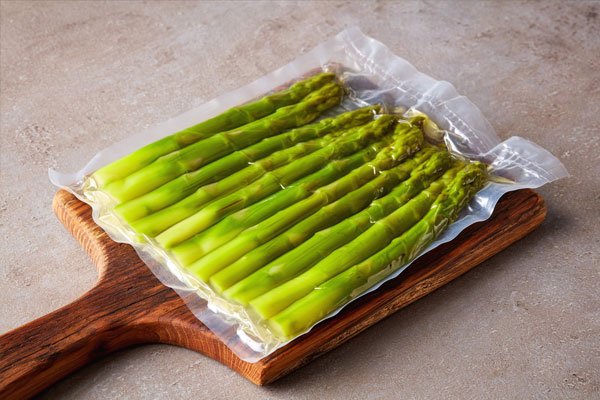
Equipment You’ll Need To Dehydrate Asparagus

If dehydrating vegetables is part of your homestead or garden plan, it’s worth the investment to purchase an electric dehydrator. They can be expensive, but prices vary, and you don’t need anything fancy. You can get a lot of mileage out of the simplest dehydrator for preserving vegetables, fruits, and meats.

Equipment To Dehydrate Asparagus
- Dehydrator
- Cutting board
- Knife
- Colander or strainer
- Pot for blanching
- Drying trays or racks
- Conditioning/storage containers
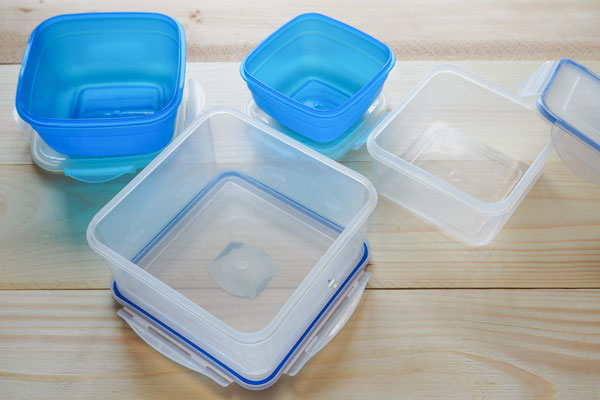
Steps To Dehydrating Asparagus

You’ll need to set your dehydrator to 140° F and set out the trays. Once ready, it will take 4–6 hours in the electric dehydrator. I closely monitor the asparagus toward the end since they can easily scorch. Keep in mind that if you cut your asparagus into pieces, your cooking times will vary depending on size.
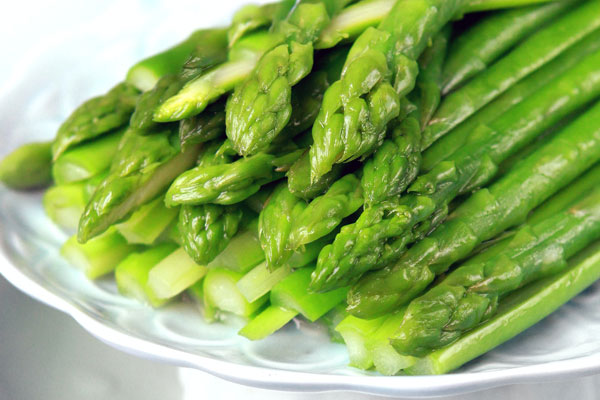
The tender tips take the least amount of time to dehydrate. Middle cuts finish next, and the cut, fibrous ends take the longest to dry.
Dehydrating Asparagus Steps
- Wash Your Asparagus ThoroughlyWash the asparagus to remove dirt and debris, especially if you’re not peeling it. Washing thoroughly helps avoid small particles that can cause bacterial growth and ruin your batch.
- Cut Off Ends Of The AsparagusCut off and separate the ends from the upper stalks. This makes it easier to ensure even drying, so you can toss the thicker pieces back in, if needed, without sifting through the entire batch.
- Peel The Stems If DesiredPeeling the asparagus skin makes the stalks more consistent in size and shape, resulting in more even drying. Green varieties tend to be a bit more consistent in size, while the white or purple asparagus stalks tend to be thicker at the bottom than at the top.
- Cut The Remaining StalksMost of the time, I cut off the tender tips and separate them from the remaining stalks. Dehydrating similar cuts together saves me time and ensures they dry evenly, preventing the need to backtrack and rehydrate pieces.
- Blanch The Asparagus By PieceDrop each piece of asparagus in boiling water for 3–4 minutes, then immediately transfer to an ice bath. Drain and keep separate.
- Arrange The Asparagus By PieceLay each type of asparagus in single layers on dehydrator trays. Remember to separate the tips and stalk pieces on keep them on their own separate trays to ensure proper drying.
- Set Your Dehydrator TemperatureRoughly, asparagus tips should be dehydrated in four hours at 140° F, middle stalks in five hours, and if you dry tough ends, that’ll take about six hours.
- Remove The Dehydrator TraysAfter removing the dehydrator trays, allow the asparagus to cool completely.
- Condition The AsparagusPlace the asparagus in an airtight container and allow some space so you can shake it briefly once a day for five days. After five days, if there’s no mold, you’re ready for storage.
- Store The AsparagusStore the dehydrated asparagus in airtight containers or resealable bags in the pantry — these can be the same containers you conditioned with. While food drying isn’t a fast-paced project, it’s an opportunity to slow down and reap the benefits of your garden into the winter months and longer.
Label the dehydrated vegetables to quickly identify them in the pantry and to track their shelf life.
How Do You Know When Your Asparagus Is Dehydrated?
You’ll know that the asparagus is fully dehydrated when it becomes crispy. Squash a piece with a fork or squeeze it with your fingers. It’s done if there’s no visible moisture.
Can You Use A Stove Instead Of A Dehydrator For Asparagus?
I prefer using a dehydrator, but you can certainly oven-dry asparagus. However, this process may require some trial and error. Like I mentioned, each asparagus piece dehydrates at slightly different rates.
Keeping your oven at a consistently lower temperature of 140° F requires constant monitoring, and it can be challenging as most conventional ovens struggle to dependably maintain such low temps.
How To Store Dehydrated Asparagus

Transfer your dehydrated asparagus to moisture-proof containers. I store my dehydrated food in glass or hard plastic containers with airtight seals like mason jars or mylar bags. Keep them in a cool, dark, and dry place in your pantry, and label them to track their shelf life.
How Long Will Dehydrated Asparagus Last
Dehydrated asparagus can last up to two years if stored in airtight containers. For optimal taste and texture, I recommend using your asparagus within a year. Take into account that asparagus beds will continue to grow and multiply annually, allowing you to replenish your dried stock.
How To Use Dehydrated Asparagus In Your Cooking

While there are lots of creative ways to use dried asparagus, I like to add it to green smoothies along with spinach and a banana or other fruit to get a boost of iron. You can also toss it in recipes for casseroles, stews, rice dishes, stir-fries, or omelets.

Fresh To Dehydrated Asparagus Conversion
When using dehydrated asparagus in a recipe, I generally use a third of the amount called for in the original recipe. If the recipe requires one cup of fresh asparagus, substitute it with approximately 1/3 cup of dehydrated asparagus.
How To Rehydrate Dehydrated Asparagus
You can rehydrate asparagus by combining one part vegetable with two parts water and simmering for 10–15 minutes or soaking it for 1–2 hours. However, if you plan to cook with the vegetables, there is no need to rehydrate them before using them in the recipe.
Dehydrating vegetables opens up a whole new way to preserve food that can be applied to other foods from your garden and even fruits like cantaloupe. There’s nothing quite like the feeling of accomplishment at the end of the day when we can taste the fruits of our labor all year long.
Your Turn!
- If you’ve tried green, purple, and white asparagus, which one is your favorite?
- Do you have a recipe to share that includes dehydrated asparagus?




Leave a Reply